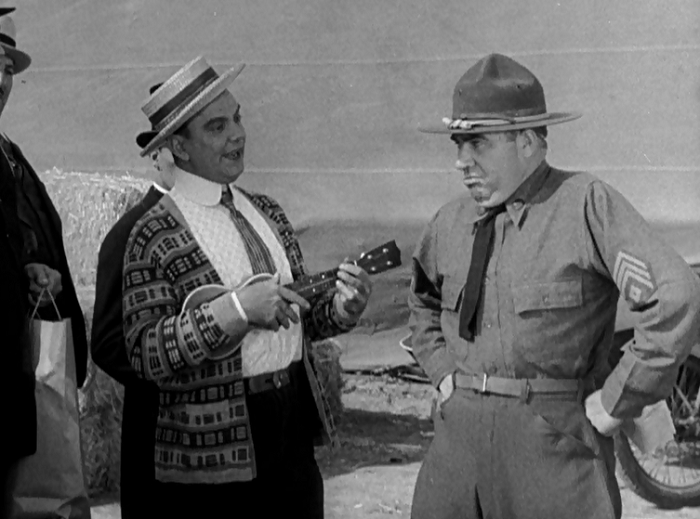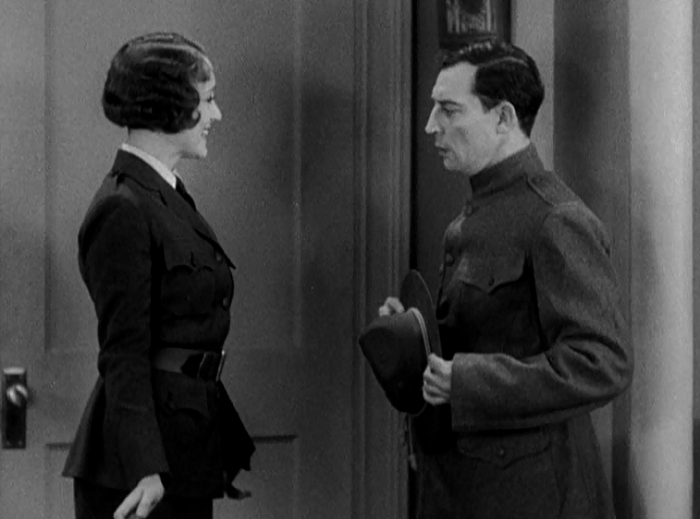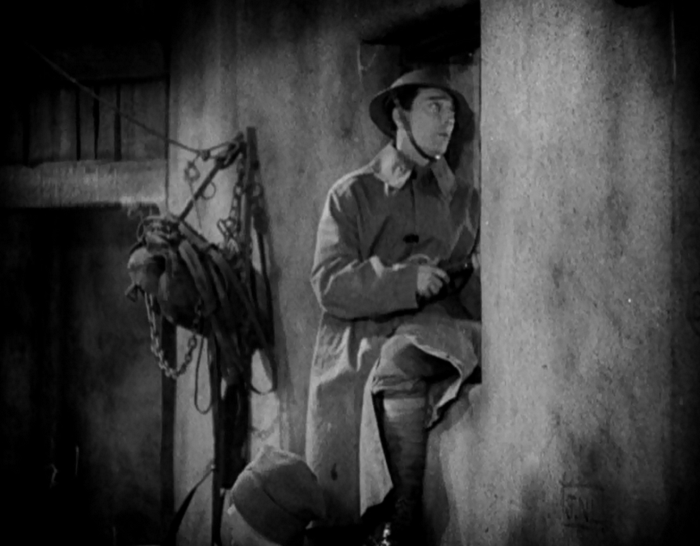 |
 |
 |
| Elmer … Buster Keaton |
Nescopeck … Cliff Edwards |
Sgt. Brophy … Edward Brophy |
Proof That It’s Pre-Code
- Here you go:
Doughboys: The Wrong Stuff
Buster Keaton was a soldier in the first World War. Shortly after finding success in his first few Fatty Arbuckle shorts, he was drafted and sent off to France. His company quickly grew fond of him, and he became a popular troop entertainer. So popular, in fact, that he was kept on long after the armistice was signed to entertain all of the men still stationed there. Keaton never complained about it, and looked back on his service with pride.
Doughboys is ostensibly inspired by this service, with the silent comedian playing a hapless schmoe named Elmer who’s a manufacturing magnate but can’t get the time of day from a pretty girl, Sally, who works in his factory. To make matters more complicated, World War I breaks out and he accidentally enlists. His clothing is rather forcibly removed; things go downhill from there.

This one is for the ladies… who want to strip Buster Keaton… while he hangs from a chandelier. Ladies.
Elmer soon meets a ragtag group of soldiers. You’ve seen a war movie before, so you know the gangly guy, the Jewish guy, and the dorky dude who keeps busting out his ukelele… They all come under the heel of a domineering drill sergeant. What Doughboys lacks in originality, it makes up for in… uh… unoriginality.
Well, the military comedy was still starting out, so I can forgive that Keaton and director Ed Sedgwick are more interested in Elmer and Sgt. Brophy’s heated rivalry. After Brophy falls for Sally, it’s a race between the two to see who can sweep her off her feet first and by that I mean not just from pushing her away from a falling bomb.
Yeah, Sally ends up in France as part of the entertainment corp, and after a number of misunderstandings (Elmer nods off in what turns out to be the bedroom of a young French girl), the two bond. Elmer has the strength and heart that Sally was looking for, and Sally can do that skirt dance, so who cares about the rest.

The goof troop.
Doughboys is kind of light and airy, and its jokes are more apt to put a smile on your face than trigger any laughter. Keaton is allowed more physical bits here than he was in Free and Easy, and he certainly seems more invested here than he is in most of his subsequent talkies. His chemistry with Cliff Edwards is sublime as well, and it should come as little surprise that the two remained close friends after the filming wrapped.
That being said, those are pretty much the high points. Most of the gags, even the physical bits, seem worn and stale. The movie never really builds a lot of momentum, and while there are good bits, there are a lot of drawn out ones that don’t pay off very well. It’s hard to hate the film, but it’s hard to invest in it either.
The screenplay is at least interesting in the way it approaches the Germans: like a lot of films from the early 30s, they seem to believe that both American and German soldiers got duped into the war, fighting for the twin nebulous concepts of love and glory, and both sides coming out with the crap end of the stick. When they meet up behind the lines, they’re cordial and sympathetic to one another’s plight. When the war ends, the Germans even wave Elmer and Sally goodbye.

Thanks for coming by the German trenches, where it’s always full of achtung.
But there’s also a strain of darkness here that one throwaway gag captures an eerie moment of truth. To the German waves, Elmer replies, “I’ll run into ya some other war sometime!” As a comment on the pessimism on the end of the war and an uncanny sense of foreshadowing, Doughboys captures the zeitgeist of the times.
Briefly, let’s talk about one noticeably unpleasant area of the picture, and that is the sound design. I know, we all love talking about sound design, but this film really shows off how tough the transition from silents to talkies were. The battalion we’ve been following throughout the film puts on a burlesque show to entertain the troops one night, which involves dancing, singing, Keaton once more in drag, and that skirt dance I posted up top. The audience remains dead silent for 99% of the performances– no mutters of excitement, no laughter, and not even a shout of disbelief at some of the ridiculous antics. It’s a prime example of how bad sound design can undermine a comedic piece; by removing the imaginary audience in the film, you make a comedic scene innately awkward.
The best moments of Doughboys are the quiet ones (that should be quiet, mind you), where some measure of bonding or understanding shines through. Elmer, Nescopeck, and the cook all on the boat to France, playing music together, or Elmer and Gustav shaking hands after not seeing one another since the beginning of the war. Doughboys has this kind of wistfulness and truth down pat, but it still has too much of a mind to be a full fledged slapstick comedy to attempt to dial it down.
There’s a sweet nugget of truth somewhere in Doughboys, but its lost amid a lot of flailing and talking. I think had this movie been made in 1933 with a still-sober Keaton where the screenwriters may have had some extra leeway, it could have been something to reckon with. As it is, it’s an inoffensive curiosity.
Gallery
Here are some extra screenshots I took. Click on any picture to enlarge!
Trivia & Links
- For a brief record that talks about Keaton’s time in the armed forces and his job entertaining the troops, The Doughboy Center has a pretty nice description.
- TCMDB talks some more about how the film was partially inspired by Keaton’s own experiences in France during World War I. I think it’s interesting seeing World War vets making their own interpretations of the war, though saying that Keaton’s The Doughboys is along the lines of Oliver Stone’s Platoon may be pushing it.
- Greenbriar Picture Show talks about the film’s budget and the production of its foreign versions. For Free and Easy, The Doughboys, and Parlor Bedroom and Bath, MGM recorded talkie versions of the picture in other languages simultaneously with different leading ladies. This meant that Keaton often had to record the same scene two or three times while phonetically pronouncing Spanish, French or German. Since a lot of the stunts didn’t involve talking, those were usually consistent between the prints. The more you know!

You can also read a commentary on PTSD in the film’s final moments, but I think that may be stretching it at this point.
- Dr. Macro has a couple of stills for this film, though they do little to indicate that it is a comedy. He also notes that the camp cook is played by the film’s director, Ed Sedgwick.
- A permeation of one of the lines from Free and Easy— “Save the last bullet for yourself”– shows up again here. No comment besides that, except that was the funniest line in both movies for me.
Awards, Accolades & Availability
- This film is available on Amazon and Warner Archive, and can be rented from Classicflix.
 |
Comment below or join our email subscription list on the sidebar!Home | All of Our Reviews | What is Pre-Code? |



















6 Comments
Paul · August 16, 2013 at 7:44 am
Now this one I did see once and was also uninspired. I love Keaton, but he just feels lost in these ones. You know what I wouldn’t mind seeing in more films today… skirt dances. Well that, and chandelier strip shows.
Danny · August 16, 2013 at 7:57 am
That skirt dance goes on for quite a while too, while the large audience of soldiers remains completely silent. Perhaps the most noticeably fake moment in the film.
Page (@ACaryGrantFan) · August 17, 2013 at 12:08 pm
I really enjoyed your honest and delightful review of Doughboys and your animated gifs are everything! : )
Dang you Will E. Hays with your gigantic ears and the studios for not fighting harder against censorship, art and our desire for debauchery, entertainment. Ha HA
While Doughboys wasn’t the best of vehicles for Keaton and the script was a bit on the weak side I’m in the, Any film that showcases Buster doing what he did best, even while mediocre, is alright by me. : )
See ya soon!
Page
Danny · August 18, 2013 at 2:47 pm
Thanks Page. Yeah, his physical comedy, when present, is still pretty spot on, but the scripts weren’t doing him any favors. Thanks for dropping by!
Emily · July 26, 2014 at 7:01 am
That this film is so mediocre makes me angry. I have a hard time imaging that even a 1930 audience could be amused, but seeing as these horrid Keaton-MGM talkies made more money than his classic silent films did… well, that’s depressing. I imagine it must have depressed Buster too.
Danny · July 28, 2014 at 9:53 am
Yeah. … Yeah. Pretty much.
Comments are closed.